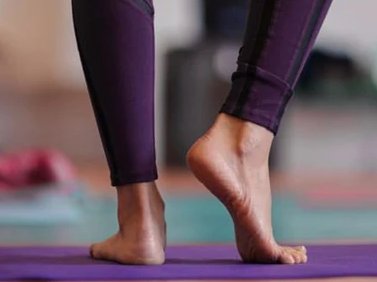Metatarsalgia &
Morton’s Neuroma
Injury Guide

As an athlete, your feet endure tremendous stress and strain during training and competition. However, certain conditions can hinder your performance and cause discomfort, impacting your ability to excel in your sport. Two common foot conditions that athletes may encounter are metatarsalgia and Morton’s neuroma. In this essay, we will explore the symptoms, causes, and rehabilitation strategies for these conditions, empowering you to take control of your foot health and achieve optimal performance.
Symptoms:
Metatarsalgia refers to pain and inflammation in the ball of the foot, specifically the metatarsal region. Athletes who engage in high-impact activities, such as running or jumping, are particularly susceptible to this condition. Symptoms of metatarsalgia may include pain and tenderness in the ball of the foot, a sharp or burning sensation, numbness or tingling in the toes, worsening discomfort during physical activity, and painful sensation while standing or walking barefoot.
Anatomy:
The metatarsals, a group of long bones in the midfoot, connect the toes to the tarsal bones of the rearfoot. They play a crucial role in weight-bearing and propulsion during walking, running, and jumping.
Metatarsalgia primarily affects the metatarsal heads, the rounded ends of the metatarsal bones that bear a significant amount of pressure during activities, but metatarsalgia can refer to dysfunction and stress generally in the forefoot. Excessive stress on these areas can lead to inflammation, pain, and discomfort. Athletes often experience metatarsalgia due to high-impact activities that place repetitive stress on the metatarsals, resulting in an overload of the surrounding soft tissues.
Morton’s neuroma, on the other hand, involves a specific nerve in the foot, most commonly between the third and fourth toes. The intermetatarsal nerves, which run alongside the metatarsal bones, can become compressed or irritated, causing the development of a neuroma—a thickened and enlarged nerve bundle. This compression typically occurs in the space between the metatarsal heads, resulting in pain, numbness, and a sensation of having a foreign object in the foot.
The implications of these conditions are significant for athletes. Metatarsalgia can hinder propulsion and weight transfer, leading to a loss of power, stability, and agility. Pain and discomfort in the ball of the foot can affect push-off during running and jumping, compromising performance. Similarly, Morton’s neuroma can cause sharp pain and numbness, disrupting an athlete’s ability to maintain balance and perform precise movements.
Causes:
Causes of metatarsalgia can vary, but often include excessive pressure or repetitive stress on the metatarsal heads, ill-fitting footwear, high-impact activities without proper conditioning, overpronation (excessive inward rolling of the foot), and foot deformities, such as hammertoes or bunions.
Rehabilitation strategies for metatarsalgia focus on relieving pain, reducing inflammation, and restoring foot function. Latitude Physiotherapy offers a range of targeted treatments, including customized exercise programs to strengthen and improve flexibility in the foot. We can also provide manual therapy techniques like soft tissue mobilization and massage, stretching to alleviate pain and promote healing. Temporary orthotic prescription for proper support and pressure redistribution, gait analysis to identify abnormalities and recommend corrective measures, and guidance on activity modification to incorporate rest periods for adequate recovery are also important considerations.
Morton’s neuroma is a nerve-related condition that commonly affects the area between the third and fourth toes. Athletes involved in sports that involve repetitive forefoot loading, such as running or jumping, are prone to developing this condition. Symptoms of Morton’s neuroma may include burning pain in the ball of the foot or between the affected toes, numbness or tingling in the toes, feeling like there’s a pebble or small object in your shoe. Symptoms may worsen during physical activity, and improve when removing footwear or massaging the foot.
Several factors contribute to the development of Morton’s neuroma, including compression or irritation of the nerve between the metatarsal bones, repetitive trauma or injury to the foot. Wearing tight or narrow shoes that squeeze the toes together, foot deformities such as high arches or flat feet, and excessive pronation or abnormal foot mechanics are other possible precipitating factors.
Rehabilitation strategies for Morton’s neuroma aim to alleviate pain, reduce inflammation, and improve nerve function. At Latitude Physiotherapy, we provide various interventions such as proper footwear recommendations with adequate room in the toe box, orthotic recommendations, and metatarsal padding for pain relief and pressure reduction. We also provide manual therapy techniques to address tissue restrictions and nerve compression, and individualized exercise programs to promote foot strength and flexibility. Use code XVDHLCWE at medbridgego.com to see our favorite exercise to improve forefoot mobility and lower limber limb alignment.
Metatarsalgia and Morton’s neuroma can significantly impact an athlete’s performance and overall foot health. By understanding the symptoms, causes, and rehabilitation strategies for these conditions, athletes can take proactive steps towards overcoming them. Our physical therapy clinic is dedicated to providing comprehensive care and support, tailored specifically for athletes. Schedule a personalized treatment today!
Let’s
Work
Together
Ready to get started? Click here. General questions? Read our FAQ page. Have a specific question? Leave us a message!
